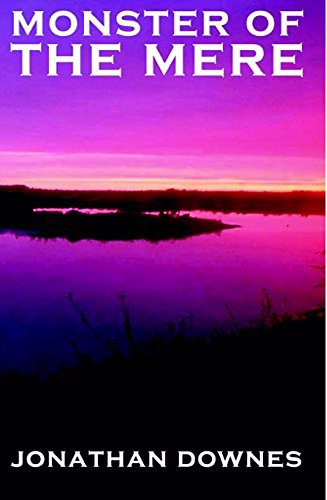When it comes to the exciting matter of mysterious water-based monsters, just about everyone has heard of the Loch Ness Monster(s). Nessie also has its very own cousin: Morag, which has been seen on many times in Scotland’s Loch Morar. It, too, is a long necked beast, strongly suggesting that it is the very same kind of animal that is in Loch Ness. Now, moving on, there is Ogopogo, Champ and even one with the title of Big Wally – not a particularly exciting or dangerous title, though! And, there is another mysterious animal – known as Marty – that caused more than a bit of havoc and excitement two decades ago. And that is what today’s article is about: a strange story that had the media foaming at the mouth. So, with all of that said, let’s begin the story. Twenty years ago something mysterious went down in the waters of a certain portion of northern England. The Devon, U.K.-based Center for Fortean Zoology (CFZ) quickly undertook an investigation into a very strange story that filtered out of Lancashire. And it wasn’t long before word was out that there was a monster around.
Many reliable witnesses – all seasoned bird watchers, I should stress - saw swans being attacked and dragged underwater by some large, powerful unseen predator at Martin Mere bird reserve. Luckily all of the birds managed to fight off the aquatic assailant and make it back to the shore. One, however, had its wing-feathers so badly bitten that it could not migrate to Iceland in the summer and, as a result of that, remained right there on the Mere. The 50,000+ swans and geese were so spooked that they left the Mere on several occasions. I’ll now hand you over to Jonathan Downes – the Director of the Center for Fortean Zoology (CFZ) who very generously tells the story of the slightly surreal investigation: “Fearing a hoax we rang the Mere and spoke to the chief warden Pat Wisniewski who confirmed the odd yarn and had even seen some immense animal swimming in the Mere. Pat welcomed the idea of a CFZ investigation. Hence Jon Downes, Graham Inglis, Richard Freeman, and then-new-addition John Fuller took the 300 mile plus trip to track this titan from the abyss in its inky watered lair.”

The story had only just begun, as Jon said: “We intended to sweep the lake with an electronic fish finder and attempt to bait the animal to the surface and hopefully photograph and identify it. We agreed that a giant wels catfish was the most likely candidate. A pike would need to be exceptionally large to attack a swan and would have probably left lacerations with its teeth, unlike the sucking bite of the catfish.” Jon continues: “Pat turned out to be one of the very nicest blokes we have met. Anyone who includes Dr Who, HP Lovecraft and Hawkwind amongst his likes must be a good egg. He had arranged for us to sleep in the Rains hide overlooking the deepest part of the Mere. Though the Mere was very beautiful our hearts fell as we walked around it on the evening of our arrival. The Mere was shallow, muddy and only a few hundred feet across. Richard especially doubted that it could support a large predator. By 9.30 that night he was eating his words.”
You might have guessed that, as Jon said there was much more to come. And it did: “While walking around the Mere`s edge Richard came upon a massive fish basking in the shallows. It`s black, oily, scale-less back bore a small dorsal fin . Disturbed the massive animal made off and dove in a tremendous swirl to reappear briefly further out close to a small island.. It dove again in amidst a huge disturbance. It`s length was hard to estimate as only the back broke the surface but if it was attacking swans the team agreed it would have to be around 8 feet long. Next day the dinghy, “Waterhorse” (named after Nessie-seeker Tim Dinsdale’s boat), was inflated and the fish finder deployed to gauge the depth of the Mere. In summer the depth is far less than winter. Many areas of the Mere were only 18 inches or so deep and badly silted up. A couple of areas, including were the sighting had occurred, were deeper. Graham set out to map the lake and it`s islands as this had not been done in detail before. We intended to make a 3d map of the Mere`s depth as well. This was swiftly abandoned after the second sighting that took place in the same place as the first. At 11 am Richard saw the huge fish again. This time it was just beneath the surface. It threw it`s elongate body into a violent ‘s’ shaped curve and thrashed the water as it disappeared. The description fitted none of the fish known to be resident in the Mere but recalled a wels.”

The story went on and Jon and the whole team sought to solve the water-based mystery: “The wels is a solitary fish. It lives mostly in the still, deoxygenated waters of lakes, marshes and lagoons, but can also be found in the lower reaches and backwaters of slow-flowing rivers. Unusually for a catfish it is tolerant of both heavy industrial pollution and salt water and is found naturaly in the brackish water of certain parts of the Black and Baltic Seas. Wels are nocturnal, choosing to feed after dark. They are voracious predators, especially when adults. Lever lists prey species as including: “turbot, bream, crayfish, eels, frogs, roach, tench, ducklings, goslings and occasionally water-voles.They have even been reported as man-eaters. Lever cites an authority called Valenciennes (presumably the eminent 19th Century Ichthyologist) as saying: “In the year 1700, on the 3rd of July, a countryman took one near Thorn for Torun, Poland] which had the entire body of an infant in its stomach.” Lever also quotes someone called Grossinger (whom I have been unable to identify further) as saying that a Hungarian fisherman discovered the corpse of a woman in another “having a marriage ring on her finger and a purse full of money at her girdle.”
Jon and the gang uncovered some fascinting intriguing data, as he showed in his diaries: “The evidence available to us leads us to conclude that the giant fish may have been introduced to Lancashire by Frank Buckland of the Acclimatization Society after his visit to Southport in the 1870s. Full details of this and the other evidence which has led us to this conclusion can be found in Jon`s forthcoming book on the expedition. After this the mapping of the Mere`s depth was abandoned to concentrate on the area we believed to be the monster`s lair. We set up a rope between the shore and a small island. From this we dangled the fish finder’s transducer into the water and set up the display screen on land. John Fuller kept watch with a camera and we baited the area heavily.”
And, let’s see what else Jon says: “Firstly we used duck pellets, which were roundly ignored. Later we tried bait balls made from corn beef and sardines (our staple diet for the mission). Still the monster did not rise. Finally the cadaver of a dead lapwing was employed but even this mouth-watering morsel could not tempt the beast. However four large soma contacts were recorded by John Fuller over the next few days. During the course of the next few days Graham completed a map of the lakeshore and islands and we carried out over 60 interviews with media from around both the country and the world i! The media circus reached it`s zenith with several live broadcasts on Sky News.”
And, finally, we have these fascinating words from Jon: “Though we did not photograph the monster we confirmed its existence and are confident that it is in fact a wels catfish. We also filmed they eye-witness testimonies of many of the birdwatchers who saw the attacks including Pat himself. On return to Exeter we called on by GMTV within 24 hours. They paid for us to return to the Mere for a live broadcast. They set up underwater cameras (next to useless in the pitch waters of the Mere) and interviewed us throughout the morning. At one point something large broke the surface of the water behind the presenter but this may have been a large carp. Nothing further was gleaned on this extra day at the Mere. If the monster causes as much disruption this winter as it did over the last, Pat is considering calling us in again to net the beast and move it to a smaller pool not used by over-wintering waterfowl. The beast has become quite a tourist attraction upping the numbers of visitors to the Mere. In the tradition of giving lake and sea monsters awful names, the CFZ have christened Martin Mere`s monster ‘Marty.'” Twenty years later, the story still circulates where and when monster-hunters hang out.
It’s highly unlikely that Marty (if he is still alive, of course…) will ever reach the levels of fame (or of infamy) of the Loch Ness Monster, Ogopogo and Champ. Big Wally, too! However, twenty years ago, and admittedly briefly, there was an undeniable media wave that placed Jon and his fellow-monster-hunters on TV, radio and more. Newspapers. The Net. Everywhere. I followed the story when it happened – those twenty years ago – and there’s no doubt, at all, that something of size was swimming around. Of course, Marty wasn’t a monster; but there was a riddle. Marty, however, did create a huge amount of entertainment. And a lot of intrigue, too. The story went on for quite a while and Jon and the team were careful to note any and all reports that came their way. Unlike Nessie, this scaled-down mystery does not have the massive fascination that Nessie definitely does. But, as well as entertaining people and the media, Marty demonstrated that even in the present day, there are mysteries to be investigated and solved.

There was just one more thing: such was the publicity, Jon decided to write an entire book on the saga. Its title Monster of the Mere. On the back of the cover of the book we’re told by Jon: “It all starts on Valentine’s Day 2002 when a Lancashire newspaper announces that “Something” has been attacking swans at a nature reserve in Lancashire. Eyewitnesses have reported that a giant unknown creature has been dragging fully grown swans beneath the water at the Wildfowl and Wetland’s Trust reserve at Martin Mere near Ormskirk. An intrepid team from the Exeter based Centre for Fortean Zoology [CFZ], led by the author, make two trips – each of a week – to the lake and its surrounding marshlands. During their investigations they uncover a thrilling and complex web of historical fact and fancy, quasi Fortean occurrences, strange animals and even human sacrifice. All this is set against the background of the author bravely trying to come to terms with the death of his mother, and his own debilitating illnesses. This is an exciting, intelligent, and emotionally charged adventure story, and includes a compelling account of historical detective work.” And yes…They do solve the mystery.
And that is a very good thing: in many expeditions so-called cryptids remain elusive. In fact, so often the creatures are beyond elusive. Not in this case, however. The CFZ team identify the creature, and they do it in a good, solid way. And there is no harm to the “monster” itself.
